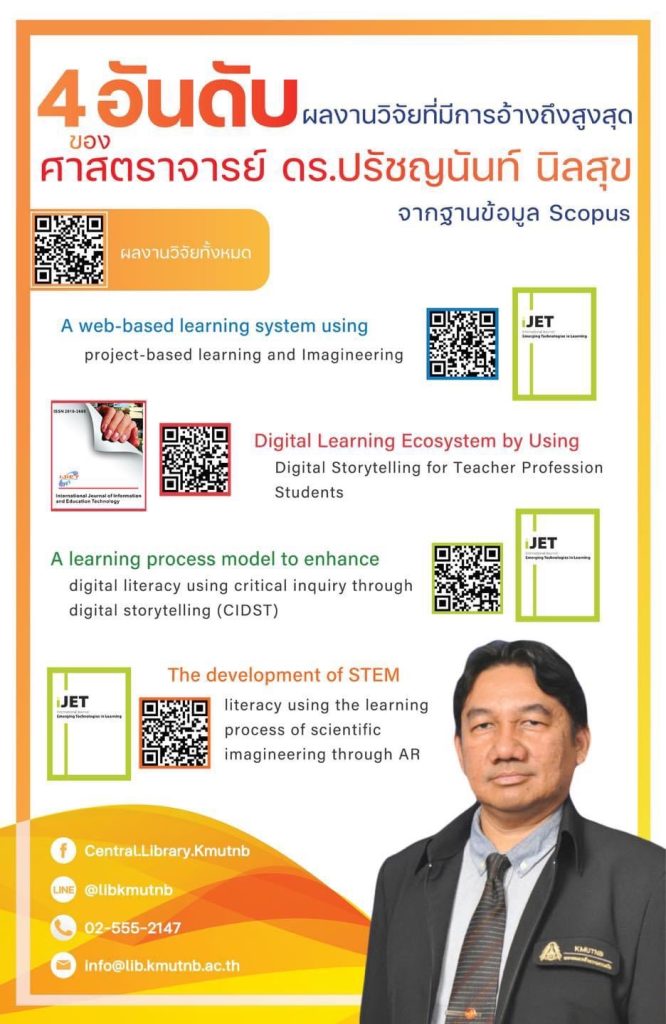บทคัดย่อการวิจัยนี้มีจุดมุ่งหมายเพื่อวิเคราะห์ความสัมพันธ์ของปัจจัยความสามารถในการใช้งานของเว็บไซต์ หน่วยงานภาครัฐระดับกระทรวง กลุ่มตัวอย่างที่ใช้ในการวิจัย คือเว็บไซต์หน่วยงานภาครัฐระดับกระทรวงในประเทศไทย
จำนวน 20 เว็บไซต์ และประชาชนผู้เคยเข้าใช้งานเว็บไซต์ จำนวน 427 คนเครื่องมือที่ใช้ในการวิจัยครั้งนี้ คือ แบบสอบถามและแบบบันทึกข้อมูลเว็บไซต์ ผลการวิจัยพบว่า ความสัมพันธ์ของปัจจัยความสามารถในการใช้งานของเว็บไซต์ หน่วยงานภาครัฐระดับกระทรวง พบว่า มีปัจจัย 5 ด้าน ที่มีความสัมพันธ์กับความสามารถในการใช้งานของเว็บไซต์หน่วยงานภาครัฐระดับกระทรวงในระดับปานกลาง ได้แก่ ปัจจัยด้านการให้บริการของหน่วยงาน ปัจจัยด้านการมีส่วนร่วมของประชาชน ปัจจัยด้านคุณลักษณะที่ควรมี ปัจจัยด้านความมั่นคงปลอดภัยสำหรับเว็บไซต์ และปัจจัยด้านการประกาศนโยบาย มีปัจจัย 3 ด้านมีความสัมพันธ์ในการใช้งานของเว็บไซต์หน่วยงานภาครัฐระดับกระทรวงในระดับค่อนข้างต่ำ ได้แก่ ปัจจัยด้านการตั้งชื่อเว็บไซต์ภาครัฐปัจจัยด้านข้อมูลพื้นฐานเกี่ยวกับหน่วยงานและปัจจัยด้านข้อมูลเปิดภาครัฐ
คำสำคัญ : ความสามารถในการใช้งานของเว็บไซต์ ,เว็บไซต์หน่วยงานภาครัฐ, การวิเคราะห์เว็บไซต์
คฑาวุธ เกษสระ, ศุมรรษตรา แสนวา และปรัชญนันท์ นิลสุข (2567)
การวิเคราะห์ความสัมพันธ์ของปัจจัยความสามารถในการใช้งานเว็บไซต์หน่วยงานภาครัฐระดับกระทรวง.
วารสารมนุษยศาสตร์และสังคมศาสตร์ มหาวิทยาลัยธนบุรี. 18(3), 52–61.
https://so03.tci-thaijo.org/index.php/trujournal/article/view/274753/185276
Kessara, K., Saenwa, S. ., & Nilsook, P. . (2024).
An Analysis Relationship of the Usability Factors of Government Ministry Websites in Thailand.
Journal of Humanities and Social Sciences Thonburi University, 18(3), 52–61.Retrieved from https://so03.tci-thaijo.org/index.php/trujournal/article/view/274753

